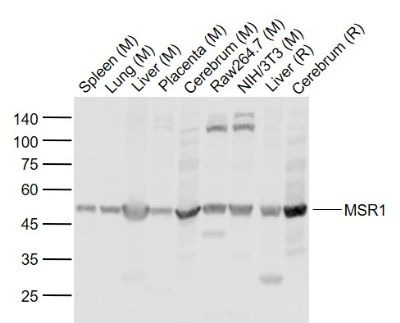Shopping Cart
Remove All Your shopping cart is currently empty
Your shopping cart is currently empty
Anti-CD204/MSR1 Polyclonal Antibody is a Rabbit antibody targeting CD204/MSR1. Anti-CD204/MSR1 Polyclonal Antibody can be used in WB.
| Pack Size | Price | USA Warehouse | Global Warehouse | Quantity |
|---|---|---|---|---|
| 50 μL | $221 | 7-10 days | 7-10 days | |
| 100 μL | $372 | 7-10 days | 7-10 days | |
| 200 μL | $529 | 7-10 days | 7-10 days |
| Description | Anti-CD204/MSR1 Polyclonal Antibody is a Rabbit antibody targeting CD204/MSR1. Anti-CD204/MSR1 Polyclonal Antibody can be used in WB. |
| Synonyms | SR-A, SRA, SCARA1, phSR2, phSR1, macrophage scavenger receptor 1, CD204 |
| Ig Type | IgG |
| Reactivity | Mouse,Rat |
| Verified Activity | Sample: Lane 1: Spleen (Mouse) Lysate at 40 μg Lane 2: Lung (Mouse) Lysate at 40 μg Lane 3: Liver (Mouse) Lysate at 40 μg Lane 4: Placenta (Mouse) Lysate at 40 μg Lane 5: Cerebrum (Mouse) Lysate at 40 μg Lane 6: Raw264.7 (Mouse) Cell Lysate at 30 μg Lane 7: NIH/3T3 (Mouse) Cell Lysate at 30 μg Lane 8: Liver (Rat) Lysate at 40 μg Lane 9: Cerebrum (Rat) Lysate at 40 μg Primary: Anti-MSR1 (TMAB-00345) at 1/1000 dilution Secondary: IRDye800CW Goat Anti-Rabbit IgG at 1/20000 dilution Predicted band size: 50/39 kDa Observed band size: 50 kDa  |
| Application | |
| Recommended Dose | WB: 1:500-2000 |
| Antibody Type | Polyclonal |
| Host Species | Rabbit |
| Subcellular Localization | Membrane; Single-pass type II membrane protein. |
| Tissue Specificity | Isoform I, isoform II and isoform III are expressed in monocyte-derived macrophages. |
| Construction | Polyclonal Antibody |
| Purification | Protein A purified |
| Appearance | Liquid |
| Formulation | 0.01M TBS (pH7.4) with 1% BSA, 0.02% Proclin300 and 50% Glycerol. |
| Concentration | 1 mg/mL |
| Research Background | This gene encodes the class A macrophage scavenger receptors, which include three different types (1, 2, 3) generated by alternative splicing of this gene. These receptors or isoforms are macrophage-specific trimeric integral membrane glycoproteins and have been implicated in many macrophage-associated physiological and pathological processes including atherosclerosis, Alzheimer's disease, and host defense. The isoforms type 1 and type 2 are functional receptors and are able to mediate the endocytosis of modified low density lipoproteins (LDLs). The isoform type 3 does not internalize modified LDL (acetyl-LDL) despite having the domain shown to mediate this function in the types 1 and 2 isoforms. It has an altered intracellular processing and is trapped within the endoplasmic reticulum, making it unable to perform endocytosis. The isoform type 3 can inhibit the function of isoforms type 1 and type 2 when co-expressed, indicating a dominant negative effect and suggesting a mechanism for regulation of scavenger receptor activity in macrophages. [provided by RefSeq, Jul 2008] |
| Immunogen | KLH conjugated synthetic peptide: human MSR1/CD204 |
| Antigen Species | Human |
| Gene Name | MSR1 |
| Gene ID | |
| Protein Name | Macrophage scavenger receptor types I and II |
| Uniprot ID | |
| Biology Area | Heart disease,Lipoprotein metabolism,Macrophage / Inflamm.,Innate and adaptive immunity,Lipoprotein metabolism |
| Function | Membrane glycoproteins implicated in the pathologic deposition of cholesterol in arterial walls during atherogenesis. Two types of receptor subunits exist. These receptors mediate the endocytosis of a diverse group of macromolecules, including modified low density lipoproteins (LDL). Isoform III does not internalize actetylated LDL. |
| Molecular Weight | Theoretical: 50 kDa. |
| Stability & Storage | Store at -20°C or -80°C for 12 months. Avoid repeated freeze-thaw cycles. |
| Transport | Shipping with blue ice. |
| Size | Quantity | Unit Price | Amount | Operation |
|---|

Copyright © 2015-2025 TargetMol Chemicals Inc. All Rights Reserved.